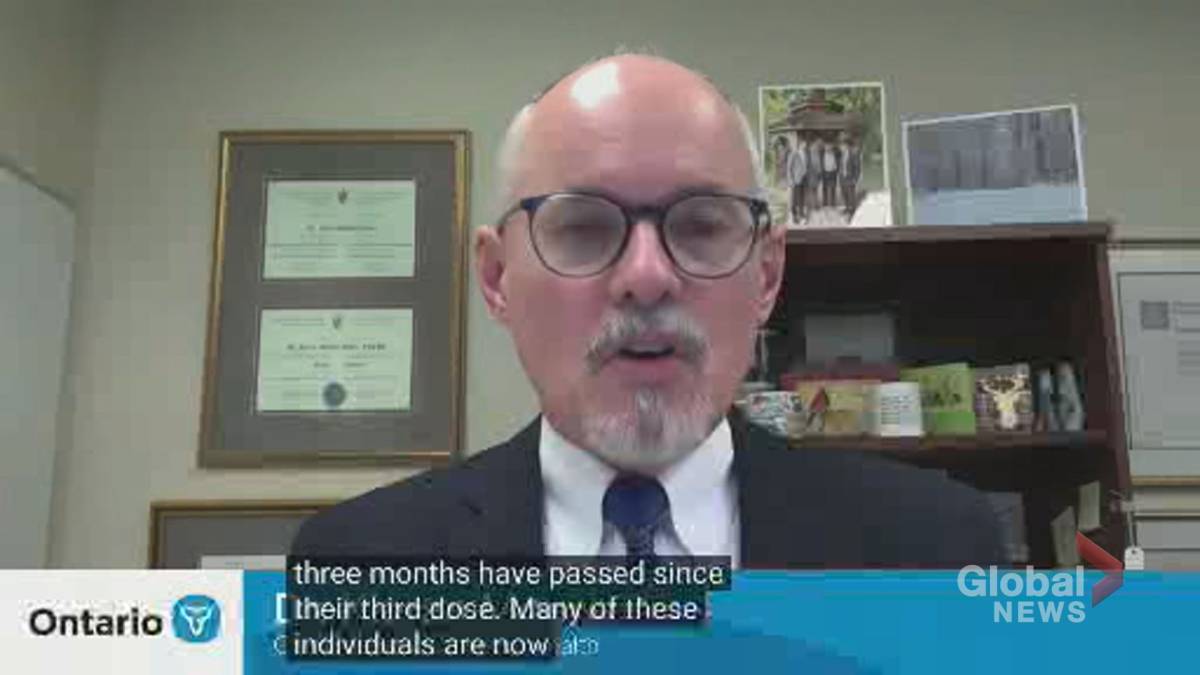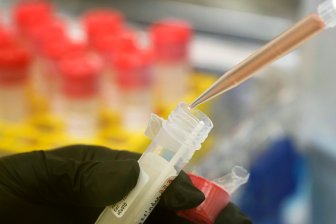On a day when Ontario recorded its highest total of COVID-19 cases reported in 24 hours, the province’s chief medical officer for health announced new actions to “limit transmission” of the emerging variant of Omicron, including adjusting the isolation tests and strategies.
Of the record 13,000 new cases released by the province on Thursday, Hamilton contributed 998 of them, bringing the city’s current active cases to more than 4,000 as of Dec. 30.
With the provincial case count now at 739,648, Dr. Kieron Moore revealed major changes in the availability of publicly funded PCR tests, which will now be reserved only for those deemed “vulnerable” as of Friday.
Read more:
Ontario Delays School Start Until Jan 5, Introduces More Capacity Limits Amid Rise in COVID-19
The alteration will allow free testing only for those with significant medical problems or beginning treatment, healthcare workers and residents in “higher risk settings” such as hospitals, long-term care homes and group living settings.
Additionally, people with a positive rapid antigen test result will no longer be required or encouraged to have a PCR test and tests will no longer be offered for asymptomatic people in the community.
“This means that … if you have COVID-19 symptoms and are not eligible for a PCR test and do not have access to a rapid antigen test, you must assume that you have COVID-19 and isolate, according to our revised guidelines. ” Moore said at a briefing.
Ontario is also changing the isolation period required for vaccinated people, as well as children under the age of 12, now set for five days from the onset of symptoms.
“Isolation can end after five days if symptoms resolve or improve for at least 24 hours … and masking and physical distancing are followed,” Moore said.
People exposed to someone who has tested positive for COVID, is fully vaccinated, has no symptoms, and is not living with the positive case, are advised to continue to monitor symptoms for 10 days.
Read more:
Ontario breaks previous single-day record with nearly 14,000 new COVID cases
Earlier this week, recommendations from the Centers for Disease Control and Prevention (CDC) in the U.S. reduced the recommended period of isolation and quarantine from 10 days to five, based on data suggesting that most of SARS-CoV-2 transmission occurs early in the disease course, usually one to two days before symptoms appear and two to three days after.
Thomas Tenkate, a Ryerson University professor who specializes in health and safety, believes the CDC’s decision was based on the effectiveness of vaccines and pressure on governments to keep the isolation period as low as possible to maintain a normal life for most of the population that may not be susceptible to disease.
“You have the problem of what level of risk is there to the community if you reduce it to that time period,” Tenkate told Good Morning Hamilton for CHML 900.
Read more:
Omicron Less Severe Than Delta Ontario Study Suggests As COVID Cases Rise In Canada
“It also comes down to what is the availability of the tests and what is the impact on the workforce.”
Hospitalizations also increased by another 239 in Ontario over the past day, bringing the total number of people in wards with COVID to 965.
In Hamilton, three more people were admitted to the hospital in the past 24 hours with COVID infections, bringing the total number of people who received care at St. Joe’s or Hamilton Health Sciences (HHS) to 140.
However, both networks say that the ratio of ICU number to admission remains relatively low with only a couple of patients transferred to the ICU day after day, bringing that number to 17.
Tenkate says that the doubling of COVID numbers in North America due to the new variant is affecting hospitals due to the large number of infected people.
“What we are seeing is that vaccinated people are more than unvaccinated people who go to the hospital, but who go to the ICU is the other way around, mainly they are not vaccinated,” said Tenkate.
“The vaccine is doing its job in preventing people from getting really sick.”
Moore also announced the launch of the fourth dose of the COVID mRNA vaccine for residents in long-term care (LTC) homes, nursing homes, and seniors living in congregated settings if at least three months have passed since their third. dose.
Read more:
Fourth dose of COVID offered to Ontario long-term care residents, needed boosters for staff and caregivers
Ontario has 58 outbreaks in LTC homes as of Thursday, up from 11 from Wednesday.
The Ministry of Long-Term Care reported 186 active cases among long-term care residents and 307 active cases among staff, an increase of 60 and an increase of 105, respectively, in the last day.
Three retirees and a couple of LTC households in Hamilton have reported outbreaks related to the Omicron variant, totaling 39 cases since Christmas Eve, including 20 employees and 17 residents.
Hospice physician Dr. Amit Arya, co-founder of Doctors for Justice in Long-Term Care, says the fourth dose and changes to PCR testing would likely help keep Omicron out of long-term care homes. and retirement, but suggested better masks and more Vaccines are also needed for caregivers.
“We still don’t have all healthcare workers in long-term care and essential caregivers are provided with N95 masks,” Arya said.
“The last we heard from the province, the third dose or booster injections given to healthcare workers … it was only forty-three percent. So clearly that’s not enough. “
Public school and licensed day care personnel will be required to don N95 masks when classes resume on Wednesday, January 5.
Moore said the “high-quality three-layer” fabric masks will be provided free of charge to students and children, in addition to a more rigorous detection system.
Five outbreaks were declared in Hamilton public schools Wednesday at three Catholic elementary facilities and a pair of Hamilton Wentworth District School Board (HWDSB) outlets.
Eight remain on the rise as of Dec. 30, while seven are in elementary schools.
In the last 14 days, 93 new cases of COVID have been reported at the two public meetings. Students account for 69 of those infections, with 74 cases among elementary school students and staff.
Public health is monitoring 208 COVID cases linked to 33 reported outbreaks in the city as of December 30, compared to 38 reported on Wednesday.
Nearly 500 employees at Hamilton hospitals isolate themselves over COVID
The two Hamilton hospital networks revealed that 487 workers were currently self-isolating due to an interaction with a COVID-19 case.
Most of those affected are employed by HHS, including several physicians. St. Joe’s says 133 of its employees are also in quarantine.
Twenty-four city hospital staff members were reported to have had COVID infections since Dec. 21 amid nine outbreaks reported online as of Thursday.
Seven of the surges are at HHS outlets and only a couple are at St. Joe hospitals. About 88 cases are related to those outbreaks, which also involve 63 patients.
About 79% of eligible Hamiltonians are fully vaccinated
Hamilton’s health partners administered about 9,900 doses of vaccines Wednesday, a slight decrease in injections compared to the same day a week ago when about 10,055 doses were administered.
More than 42,000 doses have been administered during the past seven days, which is a decrease from the 50,000 that were estimated to be administered in the previous seven days.
Read more:
Children born in 2017 who are not eligible for the COVID vaccine until they turn 5: Ontario
As of Wednesday, 79.3 percent of eligible Hamiltonians ages five and older have been fully vaccinated, while 84.5 percent have received at least a single dose.
Just under 86 percent of residents over the age of 12 have received a couple of injections, while about 88.5 percent have received at least one.
The city still lags behind the provincial average, which has 88.1 percent of those 12 and older fully vaccinated and 90.7 percent with at least a single dose.
More than 90 percent of people over 60 in the city are fully vaccinated.
Excluding children ages five to 11, Hamiltonians in the 18 to 24 age group account for the lowest vaccination rates of those eligible in the community with just over 78 percent fully vaccinated.
See link »
© 2021 Global News, a division of Corus Entertainment Inc.
Reference-globalnews.ca


